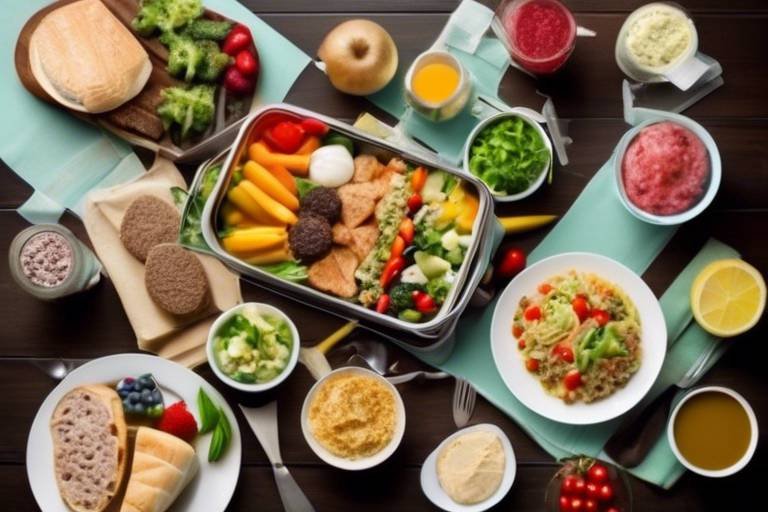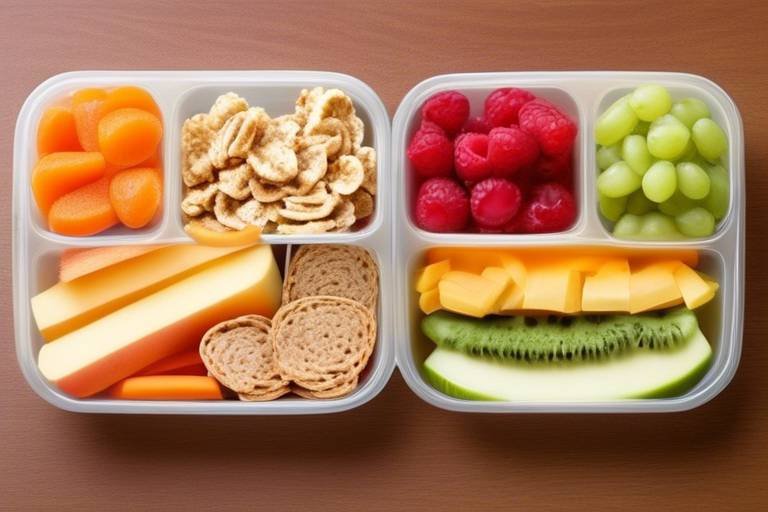Creating a Meal Plan Your Family Can Stick To
Meal planning might sound like a daunting task, but it doesn't have to be! In fact, it can be a fun and rewarding experience for the whole family. The key is to create a meal plan that not only meets everyone's nutritional needs but also caters to their tastes and schedules. By doing this, you'll not only save time and money but also ensure that your family enjoys healthy and delicious meals together. So, are you ready to dive into the world of meal planning? Let’s explore how to create a plan that your family can truly stick to!
First things first: understanding your family's food preferences is absolutely essential for a successful meal plan. Imagine trying to serve a dish that no one wants to eat—talk about a recipe for disaster! To avoid this, engage your family in discussions about their likes, dislikes, and any dietary restrictions they might have. You could even set aside some time during dinner to chat about food choices. This way, everyone feels included and valued, which can lead to a more enjoyable dining experience for all. Plus, it’s a great opportunity for your family to bond over food!
Now that you have a grasp on preferences, it’s time to set some realistic meal planning goals. Think about your family's lifestyle: how much time do you have to cook? What’s your budget? And what are your cooking skills like? Establishing achievable goals will help maintain motivation and make the meal planning process less overwhelming. Remember, the goal is to create a plan that suits your family’s unique lifestyle, not to create a culinary masterpiece every night!
Understanding your family's schedule is crucial for effective meal planning. Take a moment to evaluate your busy days—are there evenings when everyone is running around? By pinpointing these hectic times, you can allocate specific time slots for meal preparation. This ensures your plan is manageable and stress-free. For instance, if your family has soccer practice on Thursdays, you might want to plan for a quick meal or leftovers on that day.
Incorporating quick and easy recipes into your meal plan can save a ton of time during those busy weeks. Think about meals that require minimal preparation and cooking time, such as stir-fries, salads, or one-pot dishes. These options are not only time-efficient but also keep everyone satisfied and on track. After all, who wants to spend hours in the kitchen when there are more fun things to do?
Another fantastic strategy is batch cooking. This process involves preparing larger quantities of meals in advance, which can streamline your meal prep process significantly. Imagine coming home after a long day and having a delicious, healthy meal ready to go! By batch cooking, you’ll always have nutritious options available, reducing the temptation to grab unhealthy takeout. Plus, it can be a fun family activity—get the kids involved and make it a cooking party!
To keep meals exciting, it’s essential to incorporate a variety of ingredients and cuisines into your meal plan. Think of your meal plan as a colorful palette—each ingredient adds a different hue to your family’s dining experience. This variety not only prevents meal fatigue but also encourages your family to try new foods. Consider themed nights, like Taco Tuesday or Pasta Night, to keep everyone engaged and looking forward to dinner!
A well-organized shopping list is a game-changer when it comes to meal planning. It simplifies grocery trips and ensures you have all the necessary ingredients on hand. To make your shopping experience even smoother, categorize items by sections, such as produce, dairy, and grains. This can save time in the store and reduce impulse purchases. Plus, who doesn’t love checking things off a list?
Establishing a grocery budget is vital for meal planning success. Keep track of your expenses and prioritize purchases to ensure you stay within your financial limits while still enjoying nutritious meals. You might be surprised at how much you can save by planning ahead! Consider using apps or spreadsheets to monitor your spending and adjust your budget as needed.
Incorporating seasonal ingredients not only enhances flavor but can also reduce grocery costs. When you use fresh, in-season produce, you’re not just supporting local farmers; you’re also getting the best quality ingredients for your meals. Learn about local produce availability to make the most of these fresh, affordable options in your meal plan. It’s like a treasure hunt for deliciousness!
- What if my family has different dietary restrictions? - It's important to communicate and find common ground. You can prepare base meals that can be customized for each family member.
- How do I handle leftovers? - Get creative! Use leftovers in new dishes or freeze them for a later date.
- Can meal planning really save money? - Absolutely! By planning meals and making a shopping list, you can avoid impulse buys and reduce food waste.

Understanding Family Preferences
This article provides practical tips and strategies to help you design a meal plan that accommodates your family's preferences, schedules, and nutritional needs, ensuring everyone enjoys healthy and delicious meals together.
Identifying your family's food preferences is essential for a successful meal plan. Think about it: every family member has their unique tastes, and if you can tap into those likes and dislikes, you’ll create a dining experience that everyone looks forward to. Start by engaging in open discussions with your family about what they enjoy eating. You might be surprised by the variety of opinions and suggestions that come up! For instance, while one child may adore spaghetti, another might prefer tacos. By bringing everyone into the conversation, you not only gather valuable insights but also make them feel included in the meal planning process.
Don’t forget to consider dietary restrictions or allergies. If someone in the family is gluten intolerant or has a nut allergy, it’s crucial to take these into account when planning meals. You can even create a simple table to visualize everyone’s preferences and restrictions:
| Family Member | Food Preferences | Dietary Restrictions |
|---|---|---|
| Mom | Italian, Vegetarian | None |
| Dad | Grilled Foods, Mexican | None |
| Child 1 | Pizza, Tacos | Gluten Intolerant |
| Child 2 | Fruits, Pasta | Nuts Allergy |
Once you have this information, you can start crafting meals that cater to everyone’s tastes and needs. This not only boosts the chances of your family enjoying the meals you prepare but also fosters a sense of teamwork and collaboration. Try to rotate meals that everyone's excited about, and don’t shy away from experimenting with new recipes. Who knows? You might discover a new family favorite!
In addition to preferences, consider the cooking skills of each family member. If your kids are eager to help in the kitchen, you can assign them age-appropriate tasks, which can make meal prep more enjoyable and educational. Cooking together can also serve as a bonding experience, turning a chore into a fun activity. So, why not ask your family what they’d like to cook together this week? This can lead to exciting culinary adventures and create lasting memories.
In summary, understanding your family’s preferences is the cornerstone of a successful meal plan. By engaging in conversations about likes, dislikes, and dietary needs, you’ll create a more enjoyable dining experience for everyone. Remember, meal planning doesn’t have to be a chore; it can be a fun and collaborative activity that brings your family closer together!
Establishing achievable meal planning goals helps maintain motivation. Consider factors like time, budget, and cooking skills to create a plan that suits your family's lifestyle and encourages adherence.
Understanding your family's schedule is crucial for meal planning. Evaluate busy days and allocate time for meal preparation to ensure your plan is manageable and stress-free.
Incorporating quick and easy recipes can save time during busy weeks. Focus on meals that require minimal preparation and cooking time to keep everyone satisfied and on track.
Batch cooking can streamline your meal prep process. Prepare larger quantities of meals in advance to save time and ensure you always have healthy options available.
To keep meals exciting, it's important to incorporate a variety of ingredients and cuisines. This approach can help prevent meal fatigue and encourage your family to try new foods.
A well-organized shopping list simplifies grocery trips and ensures you have all necessary ingredients. Categorizing items by sections can save time and reduce impulse purchases.
Establishing a grocery budget is vital for meal planning success. Track expenses and prioritize purchases to ensure you stay within your financial limits while still enjoying nutritious meals.
Incorporating seasonal ingredients not only enhances flavor but can also reduce grocery costs. Learn about local produce availability to make the most of fresh, affordable options in your meal plan.
- How do I get my family involved in meal planning? Start by discussing preferences and cooking together. Encourage everyone to share their favorite meals.
- What if my family has different dietary restrictions? Create a meal plan that includes options for everyone, ensuring no one feels left out.
- How can I save time on meal prep? Consider batch cooking and choosing quick recipes that require minimal prep time.

Setting Realistic Goals
When it comes to meal planning, is crucial for keeping your family engaged and motivated. After all, no one wants to feel overwhelmed by a plan that feels more like a chore than a fun family activity! Start by assessing your family's daily routines and consider how much time each member can realistically dedicate to meal prep and cooking. Are there busy nights where takeout seems like the only option? Or perhaps weekends where you can cook in bulk? Understanding these dynamics will help you craft a plan that fits your lifestyle rather than fights against it.
Another key factor is your budget. Meal planning can be a fantastic way to save money, but only if you set a budget that works for your family's financial situation. It’s easy to get excited and plan elaborate meals that require expensive ingredients, but this can lead to frustration when it comes time to shop. Instead, aim for a balance between nutritious and affordable. You might want to track your grocery expenditures for a month to see where your money is going and identify areas where you can cut back without sacrificing quality. This way, you can create a meal plan that not only satisfies your taste buds but also keeps your wallet happy.
Additionally, think about your cooking skills. If you’re a novice in the kitchen, it might be best to start with simple recipes that require minimal ingredients and steps. As you gain confidence, you can gradually introduce more complex dishes. This progressive approach helps build your culinary skills and keeps the cooking experience enjoyable rather than stressful. Remember, the goal is to create a meal plan that your family can stick to long-term, so it’s important to keep things within a manageable scope.
To further enhance your planning process, consider using a meal planning template or app. These tools can help you visualize your meals for the week, making it easier to see where you might need to make adjustments. A simple table can help organize your thoughts:
| Day | Meal | Time Required | Budget |
|---|---|---|---|
| Monday | Spaghetti with Marinara | 30 mins | $10 |
| Tuesday | Chicken Stir-Fry | 25 mins | $12 |
| Wednesday | Taco Night | 20 mins | $15 |
| Thursday | Vegetable Soup | 40 mins | $8 |
| Friday | Homemade Pizza | 1 hour | $18 |
By setting these realistic goals, you not only make meal planning feasible but also create a pathway for your family to enjoy delicious and nutritious meals together. Remember, the key is to start small, stay flexible, and adjust your plan as needed. This way, your family will look forward to meal times instead of dreading them!

Assessing Time Constraints
When it comes to meal planning, one of the biggest hurdles many families face is the time crunch. Life can be hectic, with work commitments, school activities, and social obligations competing for your attention. Therefore, it's essential to take a moment to assess your family’s schedule and understand when you can realistically dedicate time to meal preparation. This evaluation will not only help you create a meal plan that fits seamlessly into your life but also reduce stress during the week.
Start by identifying the days and times when your family is the busiest. For instance, are there specific evenings when everyone is rushing to get to practice or meetings? Perhaps weekends are filled with errands or family outings? By pinpointing these time constraints, you can make informed decisions about when to cook and when to opt for simpler meals or leftovers.
Another effective strategy is to create a weekly calendar that highlights your family’s commitments. You can use a simple table like the one below to visualize your schedule:
| Day | Morning | Afternoon | Evening |
|---|---|---|---|
| Monday | School/Work | Soccer Practice | Dinner with Friends |
| Tuesday | School/Work | Dance Class | Family Dinner |
| Wednesday | School/Work | Free | Cooking Night |
| Thursday | School/Work | Guitar Lessons | Takeout Night |
| Friday | School/Work | Free | Movie Night |
| Saturday | Errands | Family Outing | Grill Night |
| Sunday | Meal Prep | Relax | Family Dinner |
By using this type of visual aid, you can see at a glance where your time is allocated and identify potential gaps for meal prep or cooking. For example, if you notice that Wednesdays are relatively free, you might choose to batch cook several meals that day, which can then be easily reheated during busier evenings.
Additionally, don’t forget to communicate with your family members about their schedules. Kids might have after-school activities that you’re unaware of, or your partner might have late meetings. Understanding everyone's commitments will allow you to adjust your meal planning accordingly. Remember, the goal is to create a plan that works for everyone, so flexibility is key!
Finally, consider the option of meal prepping on weekends. This can be a game changer! By dedicating a few hours to cook and package meals for the week ahead, you’ll save time and stress during those busy weekdays. You can prepare a variety of dishes that can be mixed and matched throughout the week, ensuring that your family enjoys both variety and convenience.
In summary, assessing your family’s time constraints is crucial for effective meal planning. By understanding your schedule, communicating with your family, and being open to adjustments, you can create a meal plan that not only meets your nutritional needs but also fits seamlessly into your busy lifestyle.
- How do I get my family involved in meal planning? Encourage discussions about food preferences and involve everyone in choosing meals for the week.
- What if my family has different dietary needs? Consider creating a base meal that can be customized with different proteins or sides to accommodate everyone.
- How can I save money while meal planning? Stick to a grocery budget, use seasonal ingredients, and plan meals around sales and discounts.
- What are some quick meal ideas for busy nights? Think of stir-fries, salads, or one-pot meals that can be prepared in under 30 minutes.

Choosing Quick Recipes
When it comes to meal planning, time is often of the essence, especially for families with busy schedules. Choosing quick recipes can be a game-changer, allowing you to whip up delicious meals without spending hours in the kitchen. Think of it like a well-timed dance; the right steps can lead to a harmonious experience for everyone at the dinner table. So, how do you find these culinary gems that won't eat up your precious time?
First, consider meals that can be prepared in 30 minutes or less. These recipes typically require fewer ingredients and simpler techniques, making them perfect for those hectic weeknights. For instance, stir-fries, salads, and one-pan dishes are fantastic options that can be customized to suit your family's tastes. Imagine tossing together colorful veggies and protein in a sizzling pan while the aroma fills the air—it's not just quick; it's also a feast for the senses!
Another effective strategy is to leverage pre-prepped ingredients. Many grocery stores offer pre-cut vegetables, marinated proteins, and even ready-to-cook meal kits. While some may argue that these options can be pricier, they can save you a significant amount of time and stress, especially when you're juggling work, school, and extracurricular activities. It’s like having a sous-chef at your disposal, ready to assist when you need it most.
For those nights when you really want to keep things simple, consider meals that can be made in bulk and enjoyed throughout the week. One-pot pasta dishes, casseroles, or hearty soups can be prepared in advance and stored in the fridge or freezer. This way, you can simply reheat and serve, giving you more time to relax and reconnect with your family after a long day. Think of it as meal prep magic—transforming your kitchen into a time-saving powerhouse!
Lastly, don't underestimate the power of leftovers. Plan meals that intentionally yield extra servings, allowing you to repurpose them into new dishes. For example, roasted chicken can be transformed into chicken tacos or a savory chicken salad the next day. This not only reduces waste but also keeps your menu fresh and exciting. It’s like turning yesterday's dinner into today's culinary adventure!
In summary, choosing quick recipes doesn't have to be a daunting task. By focusing on speed, simplicity, and creativity, you can create a meal plan that keeps your family satisfied and happy. So, the next time you're short on time, remember these strategies and let your kitchen become a place of joy, not stress.
- What are some examples of quick recipes? Quick recipes include stir-fries, salads, one-pan meals, and pasta dishes that can be prepared in 30 minutes or less.
- How can I save time while cooking? Use pre-prepped ingredients, plan meals that can be made in bulk, and repurpose leftovers to save time in the kitchen.
- Are quick recipes healthy? Yes! Quick recipes can be healthy by incorporating fresh vegetables, lean proteins, and whole grains.

Batch Cooking Strategies
When it comes to meal planning, batch cooking is like having a secret weapon in your culinary arsenal. Imagine this: you set aside a few hours on the weekend to prepare meals for the week ahead. Sounds like a dream, right? This strategy not only saves you time during those hectic weekday evenings but also ensures that you have healthy, homemade meals ready to go. So how do you get started?
First, choose a day that works best for you. For many families, Sunday is a popular choice. You can start by selecting a few recipes that can be made in larger quantities. Think about meals that freeze well, such as soups, stews, and casseroles. These dishes not only taste great but also reheat beautifully. Here’s a simple table to help you visualize what to prepare:
| Meal Type | Examples | Freezer Friendly |
|---|---|---|
| Soups | Chicken Noodle, Tomato Basil | Yes |
| Casseroles | Lasagna, Broccoli Cheddar | Yes |
| Grains | Quinoa, Brown Rice | No |
| Proteins | Grilled Chicken, Meatballs | Yes |
Next, consider prepping ingredients in bulk. Chop vegetables, marinate proteins, and measure out spices ahead of time. This step can be a game-changer during the week when you just want to get dinner on the table quickly. You can store chopped veggies in airtight containers in the fridge, which keeps them fresh and ready to toss into a stir-fry or salad.
Another key aspect of batch cooking is to label and date your meals. This simple practice can save you from eating mystery meals that have been lurking in the back of your freezer for too long. Use freezer-safe containers and label them with the meal name and date prepared. This way, you can easily grab what you need without any guesswork.
Lastly, don’t forget to involve your family in the process! Cooking together can be a fun bonding experience. You can assign tasks based on age and skill level. Kids can wash vegetables, while older ones can help with chopping or stirring. This not only makes the process quicker but also teaches valuable cooking skills to your children.
Incorporating batch cooking into your meal planning can transform your weeknight dinners from a source of stress into a time of enjoyment. Imagine coming home after a long day and simply reheating a delicious, home-cooked meal. It’s not just about saving time; it’s about creating memorable family moments around the dinner table without the last-minute scramble.
Q: How long can I store batch-cooked meals in the freezer?
A: Generally, most meals can be stored in the freezer for up to three months. Just make sure to label them with the date you prepared them!
Q: Can I batch cook for dietary restrictions?
A: Absolutely! Just choose recipes that fit everyone’s dietary needs and prepare them in larger quantities. You can also customize portions to suit individual preferences.
Q: What are some quick meals to start with?
A: Great options include chili, stir-fried veggies with rice, and baked pasta dishes. These meals are not only easy to prepare in bulk but also versatile!

Incorporating Variety
When it comes to meal planning, one of the most exciting aspects is the opportunity to explore a world of flavors and ingredients. Imagine sitting down for dinner and instead of the same old routine, you’re greeted with a colorful spread that tantalizes your taste buds. Incorporating variety not only makes meals more enjoyable but also encourages your family to embrace a wider range of nutritional benefits. So, how can you ensure that your meal plan is anything but boring?
First, think about diversifying your ingredients. Instead of relying on the standard chicken, beef, or pasta, why not experiment with different proteins like quinoa, lentils, or even tofu? These options not only provide unique flavors but also offer various health benefits. For instance, quinoa is a complete protein, making it an excellent choice for vegetarians and meat-eaters alike. By introducing new ingredients, you can create meals that are both healthy and exciting.
Next, consider exploring international cuisines. Each culture has its own culinary traditions that can inspire your meal planning. For example, you might incorporate a Mexican night with tacos, a Thai evening with green curry, or an Italian feast featuring homemade pesto pasta. Not only does this keep things fresh, but it also opens up a dialogue about different cultures at the dinner table, enriching your family’s understanding of the world.
Another fantastic way to keep meals interesting is by rotating through different cooking methods. Instead of always grilling or baking, try steaming, stir-frying, or slow-cooking. Each method brings out unique flavors and textures in your ingredients, making even the same dish feel brand new. For example, roasted vegetables can taste completely different from sautéed ones, even if they are the same vegetables!
To help you visualize this concept, here’s a quick table that summarizes some ideas for incorporating variety:
| Cuisine | Main Ingredients | Cooking Method |
|---|---|---|
| Mexican | Tortillas, beans, avocados | Grilling, frying |
| Thai | Coconut milk, lemongrass, rice noodles | Stir-frying, steaming |
| Italian | Pasta, tomatoes, basil | Baking, roasting |
| Indian | Spices, lentils, rice | Slow-cooking, simmering |
Finally, don't forget to involve your family in the planning process. Ask them about their favorite dishes from different cuisines or what ingredients they’d like to try. This not only makes them feel included but also sparks excitement about the meals to come. Who knows, your kids might surprise you with their culinary preferences!
Incorporating variety into your meal plan is like adding spices to a dish; it enhances the overall flavor and makes the experience much more enjoyable. By diversifying your ingredients, exploring international cuisines, experimenting with cooking methods, and involving your family, you can create a meal plan that is both nutritious and exciting. So, roll up your sleeves and get ready to embark on a culinary adventure!
- How often should I change my meal plan? It's a good idea to refresh your meal plan every few weeks to keep things interesting.
- What if my family is picky about food? Start by introducing small changes and involve them in the planning process to find common ground.
- Can I use frozen vegetables in my meal plans? Absolutely! Frozen vegetables are nutritious and can save you time in meal prep.

Creating a Shopping List
Creating a shopping list is not just a mundane task; it’s the secret weapon in your meal planning arsenal! It can transform chaotic grocery trips into smooth, efficient outings. Imagine walking through the aisles with a clear plan in mind, knowing exactly what to grab, and avoiding those pesky impulse buys. The key to a successful shopping list lies in its organization and thoughtfulness. Start by categorizing your items based on the layout of your grocery store. This not only saves time but also helps you avoid the temptation of wandering down aisles that don't have anything on your list.
When you sit down to draft your list, take a moment to reflect on your meal plan for the week. Jot down all the ingredients you’ll need for each recipe. This is where your earlier discussions about family preferences come into play. Perhaps someone in your family loves tacos, while another is a fan of stir-fry. Make sure to include ingredients for meals that cater to everyone’s tastes. You might want to consider creating a table to keep track of what you need:
| Meal | Ingredients |
|---|---|
| Tacos | Ground beef, taco shells, lettuce, cheese, salsa |
| Stir-Fry | Chicken, bell peppers, broccoli, soy sauce, rice |
| Pasta Night | Pasta, marinara sauce, garlic, basil, parmesan |
As you compile your list, it’s also essential to keep your budget in mind. Prices can vary greatly, so being aware of what you need versus what you want can help you stay within your financial limits. Consider prioritizing items based on necessity. You might categorize your list into 'Must-Haves' and 'Nice-to-Haves' to make sure you don’t overspend. Additionally, if you’re trying to save a few bucks, look for sales or discounts on items you regularly use.
Lastly, don't forget to include any household essentials that might not be part of your meal plan but are necessary for daily living. Items like toilet paper, cleaning supplies, or snacks for the kids can often be forgotten in the rush to focus solely on food. By taking a holistic approach to your shopping list, you ensure that your entire household runs smoothly, not just your meal planning!
- How often should I update my shopping list? It's a good idea to update your shopping list weekly, especially if you have a set meal plan.
- What if I forget an ingredient? If you forget an ingredient, don’t panic! You can often make substitutions or adjust your meal plan accordingly.
- Can I use apps for my shopping list? Absolutely! There are many apps available that can help you organize your shopping list and even track prices.

Budgeting for Groceries
When it comes to meal planning, one of the most critical aspects is . It's like setting the stage for a fantastic performance; without a solid plan, the show might not go on as smoothly as you'd hoped. First and foremost, you need to establish a realistic budget that considers your family's needs and preferences. Take a moment to evaluate your monthly income and expenses to determine how much you can comfortably allocate to groceries without breaking the bank.
Once you have a budget in mind, the next step is to track your expenses. This is where a little bit of diligence pays off. Keep a record of what you spend each week on groceries, and compare it to your budget. You might be surprised by how much those little impulse buys add up! Consider using a simple spreadsheet or a budgeting app to help you visualize your spending. This way, you can easily spot areas where you might be overspending and make adjustments accordingly.
Prioritizing purchases is another essential strategy. Not all grocery items are created equal, and some are more crucial than others for your meal plan. Start by listing out the core ingredients you need for the week, focusing on whole foods and staples that can be used in multiple meals. For instance, instead of splurging on that fancy organic snack, consider investing in versatile ingredients like rice, beans, and seasonal vegetables that can stretch across several dishes. This not only keeps your meals healthy but also helps you stay within your budget.
Additionally, consider implementing a weekly meal plan that aligns with your budget. Plan meals around sales and discounts at your local grocery store, and don't hesitate to take advantage of coupons and loyalty programs. You might even find that planning meals based on what's in season can lead to both savings and delicious flavors. Seasonal produce is often cheaper and more flavorful, making it a win-win for your wallet and your taste buds.
Lastly, don't forget to create a shopping list before heading to the store. A well-organized list can help you stick to your budget and avoid those tempting impulse buys that can derail your financial goals. Consider categorizing your list by sections of the store, such as produce, dairy, and pantry items. This way, you can navigate the aisles efficiently and ensure you pick up everything you need without unnecessary detours.
In summary, budgeting for groceries is not just about pinching pennies; it's about making informed choices that benefit your family’s health and your financial well-being. By tracking expenses, prioritizing purchases, planning meals around sales, and sticking to a shopping list, you'll find that you can enjoy delicious, nutritious meals without overspending. Remember, a little effort in budgeting can lead to significant savings, allowing you to allocate funds for other important family activities.
- How can I save money on groceries? Start by planning meals around sales, using coupons, and buying seasonal produce.
- What should I include in my grocery budget? Include all necessary items for your meal plan, along with household essentials and snacks.
- How can I avoid impulse buys at the grocery store? Stick to your shopping list and avoid shopping when you're hungry to reduce temptation.
- Is it worth it to buy organic? Consider your budget and prioritize organic for items that you consume frequently or those that are heavily sprayed with pesticides.

Utilizing Seasonal Ingredients
This article provides practical tips and strategies to help you design a meal plan that accommodates your family's preferences, schedules, and nutritional needs, ensuring everyone enjoys healthy and delicious meals together.
Identifying your family's food preferences is essential for a successful meal plan. Engaging everyone in discussions about likes, dislikes, and dietary restrictions can lead to a more enjoyable dining experience for all.
Establishing achievable meal planning goals helps maintain motivation. Consider factors like time, budget, and cooking skills to create a plan that suits your family's lifestyle and encourages adherence.
Understanding your family's schedule is crucial for meal planning. Evaluate busy days and allocate time for meal preparation to ensure your plan is manageable and stress-free.
Incorporating quick and easy recipes can save time during busy weeks. Focus on meals that require minimal preparation and cooking time to keep everyone satisfied and on track.
Batch cooking can streamline your meal prep process. Prepare larger quantities of meals in advance to save time and ensure you always have healthy options available.
To keep meals exciting, it's important to incorporate a variety of ingredients and cuisines. This approach can help prevent meal fatigue and encourage your family to try new foods.
A well-organized shopping list simplifies grocery trips and ensures you have all necessary ingredients. Categorizing items by sections can save time and reduce impulse purchases.
Establishing a grocery budget is vital for meal planning success. Track expenses and prioritize purchases to ensure you stay within your financial limits while still enjoying nutritious meals.
Utilizing seasonal ingredients in your meal planning can be a game changer. Not only do these ingredients tend to be fresher and more flavorful, but they can also be more affordable than out-of-season options. When you eat with the seasons, you’re not just supporting your health; you're also supporting local farmers and reducing your carbon footprint by choosing ingredients that are grown closer to home.
Imagine biting into a juicy summer tomato or savoring a warm bowl of butternut squash soup in the fall. Seasonal eating is about connecting with the rhythms of nature, and it can make your meals feel more vibrant and exciting. To help you get started, consider the following:
- **Research local farmers' markets**: These are great places to find seasonal produce and often offer organic options.
- **Join a community-supported agriculture (CSA) program**: This can provide you with a regular supply of fresh, seasonal ingredients.
- **Plan your meals around what's in season**: This not only helps with budgeting but also ensures that your meals are full of flavor.
Here’s a quick table to show you some common seasonal ingredients throughout the year:
| Season | Ingredients |
|---|---|
| Spring | Asparagus, Peas, Spinach, Strawberries |
| Summer | Tomatoes, Zucchini, Corn, Peaches |
| Fall | Pumpkin, Apples, Brussels Sprouts, Squash |
| Winter | Root Vegetables, Kale, Citrus Fruits, Cabbage |
By focusing on seasonal ingredients, you can create a meal plan that not only nourishes your family but also excites their taste buds. So, why not give it a try? Your meals will be tastier, your grocery bills lighter, and your family will appreciate the variety!
- How do I find out what’s in season? You can check local agricultural websites or apps that provide seasonal produce guides.
- Are seasonal ingredients more expensive? Often, seasonal ingredients are cheaper due to abundance, but prices can vary based on location and availability.
- Can I freeze seasonal ingredients? Absolutely! Freezing is a great way to preserve seasonal produce for later use.
Frequently Asked Questions
- How do I know what my family likes to eat?
Engaging your family in discussions about their food preferences is key. You can create a fun family meeting where everyone shares their favorite meals, dislikes, and any dietary restrictions. This way, you can tailor your meal plan to include dishes everyone enjoys!
- What if my family has different dietary needs?
No worries! You can create a flexible meal plan that accommodates everyone's needs. Consider making base meals that can be customized with different toppings or sides. For example, prepare a taco night where everyone can choose their fillings!
- How can I save time on meal prep?
Batch cooking is your best friend! Cook larger portions of meals and store them in the fridge or freezer. This way, you’ll always have healthy options ready to go. Also, look for quick recipes that require minimal prep time, so you can whip up dinner in a flash!
- What should I include in my shopping list?
Start by listing all the ingredients needed for your planned meals. Organize your list by grocery store sections (produce, dairy, etc.) to make your shopping trip efficient. This will help you avoid forgetting essential items and reduce impulse buys!
- How can I stick to a grocery budget?
Tracking your expenses is crucial! Set a budget for each week and prioritize your grocery list based on what you need. Consider using apps or spreadsheets to keep an eye on your spending. Remember, sticking to your budget means more money for fun family activities!
- Why should I use seasonal ingredients?
Seasonal ingredients are not only fresher and tastier but often cheaper too! They can enhance the flavor of your meals and help you discover local produce. Plus, it’s a great way to support local farmers and enjoy a variety of foods throughout the year!



















